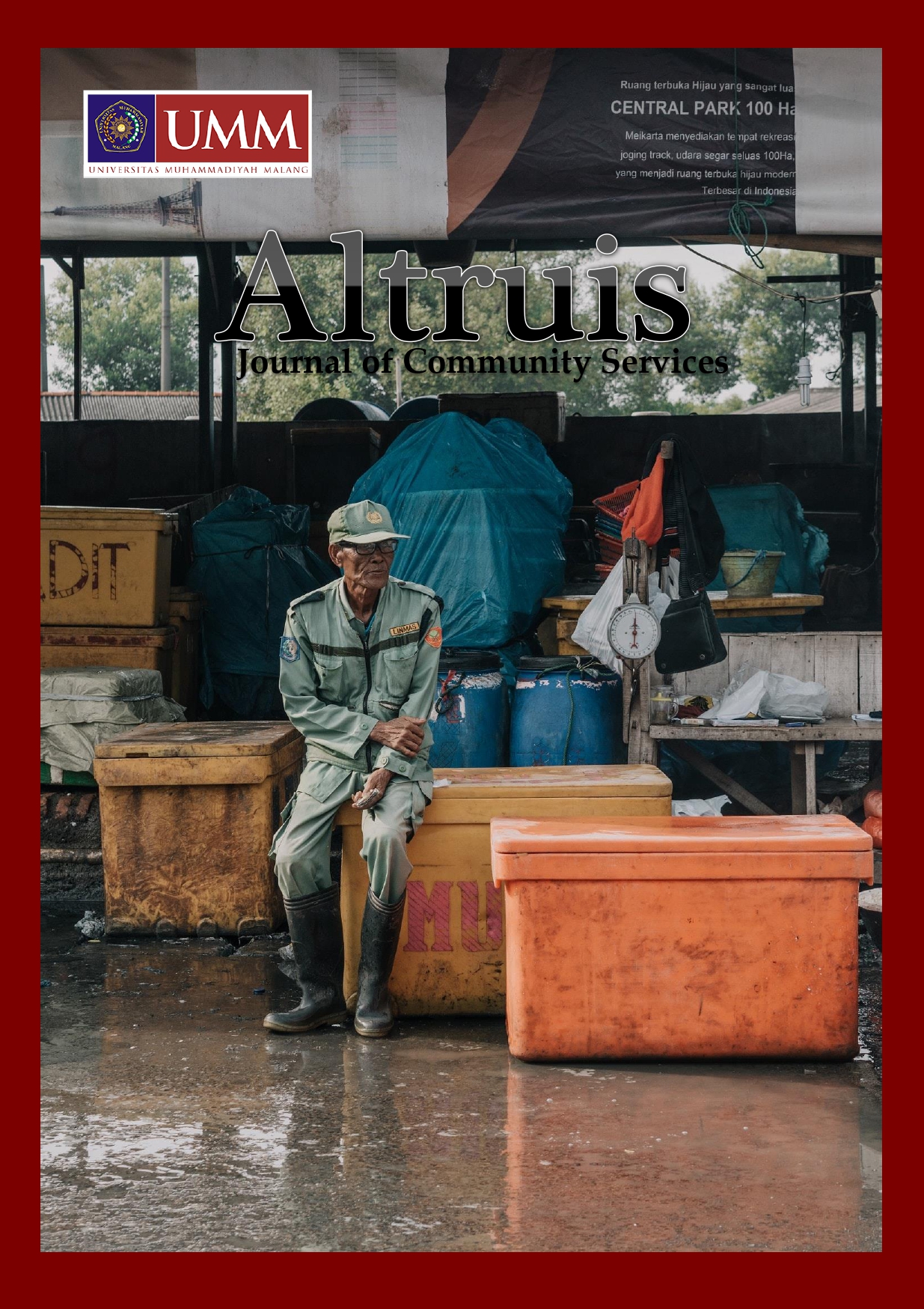Program Story Telling dengan Metode BERLIAN (Bercerita-ExpeRiential-LearnIng-ANak) untuk Menanamkan Moral pada Anak-anak
DOI:
https://doi.org/10.22219/altruis.v1i2.12163Keywords:
Story telling, instilling moral values, TPQ (Taman Pendidikan Al Qur’an)Abstract
TPQ (Taman Pendidikan Al Qur’an) merupakan sebuah tempat diselenggarakannya pendidikan dan pengajaran agama Islam khususnya Al Quran, termasuk pendidikan moral. Pada kenyataannya, program pendidikan di TPQ pada umumnya hanya mengajarkan bagaimana membaca Al Quran, tidak mengajarkan isi dan makna dari Al Quran itu sendiri, sehingga pendidikan moral kurang mendapat perhatian. Dengan demikian, hal yang penting yaitu membuat kreasi pada metode pembelajaran penanaman nilai-nilai moral menggunakan metode yang lebih menarik. Metode story telling merupakan salah satu teknik yang menarik untuk mempelajari nilai-nilai moral pada anak-anak. Program ini bertujuan untuk menerapkan metode story telling dengan metode BERLIAN (Bercerita-ExpeRiential-LearnIng-ANak) untuk menananmkan nilai-nilai moral pada anak. Strategi yang digunakan dalam program ini adalah pelatihan dan dilanjutkan dengan pemantauan dan pendampingan. Hasil pelatihan menunjukkan bahwa peserta merasakan pentingnya metode story telling yang diterapkan di TPQ untuk menanamkan nilai-nilai moral pada anak-anak. Mereka juga sepakat untuk menerapkan metode ini di TPQ, tetapi dalam penerapannya mereka terkendala dengan terbatasnya waktu, belum terbiasa, kurangnya keterampilan, dan kurangnya kepercayaan diri. Pendampingan dan tindak lanjut perlu dilakukan agar program dapat diimplementasikan dengan lebih baik.
Downloads
References
Adisusilo, S. (2012). Pembelajaran nilai karakter konstruktivis dan VCT sebagai inovasi pendekatan pembelajran afektif. Jakarta: Raja Grafindo Persada.
Al-Hawamleh, M. S. (2019). Storytelling as promoting moral consciousness: Religious education teachers’ perspectives. International Journal of Learning, Teaching and Educational Research, 18(10), 20–33. https://doi.org/10.26803/ijlter.18.10.2
Alna, O. (1999). The importance of oral storytelling in literacy development. The Ohio Reading Teacher, 31(1), 15–18.
Asfandiyar, A. Y. (2007). Cara pintar mendongeng. Jakarta: Mizan.
Ayuni, R. D., Siswati, & Rusmawati, D. (2013). Pengaruh storytelling terhadap perilaku empati anak. Jurnal Psikologi Undip, 12(2), 81–130.
Bennett, E. M. (2013). Storytelling and the moral tradition: An examination of the pedagogy of story telling for moral enculturation. In M. Rohse, J. J. Infanti, N. Sabnani, & M. Nivargi (Eds.), The Many Facets of Storytelling: Global Reflections on Narrative Complexity (pp. 13–21). Oxfordshire, United Kingdom: Inter-Disciplinary Press.
Bunanta, M. (2005). Buku, dongeng dan minat membaca. Jakarta: Pustaka Tangga.
Dwiyanti, R. (2013). Peran orang tua dalam perkembangan moral anak (Kajian teori Kohlberg). Prosiding Seminar Nasional Parenting, 161–169. http://hdl.handle.net/11617/3983
Goldberg, B. (2005). Art of the narrative: Interpreting visual stories. Art Education, 58(2), 25–32. Henniger, M. L. (2009). Teaching Young Children. New Jersey: Person Education.
Henny, S. (2007). Cara bercerita yang efektif dan menarik. Bandung: Disdik Propinsi Jawa Barat.
Kochanska, G., & Aksan, N. (2006). Children’s conscience and self regulation. Journal of Personality, 74, 1578–1618.
Kochanska, Grazyna, & Aksan, N. (2006). Children’s conscience and self-regulation. December. https://doi.org/10.1111/j.1467-6494.2006.00421.x
Mansyur. (2019). Pengembangan nilai moral anak melalui metode bercerita pada kelompok B di TK Pembina kota Kendari. Jurnal Gema Pendidikan, 26(1), 97–112.
Moelichatoen. (2004). Metode pengajaran di taman kanak-Kanak. Jakarta: Rineka Cipta.
Muallifah. (2013). Storytelling sebagai metode parenting untuk pengembangan kecerdasan anak usia dini. PSIKOISLAMIKA: Jurnal Psikologi Islam (JPI), 10(1), 98–106.
Nurgiyantoro, B. (2012). Teori pengkajian fiksi. Yogyakarta: Gadjah Mada University Press.
Royal, C. W., & Baker, S. B. (2005). Effects of a deliberate moral education program on parents of elementary school students. Journal of Moral Education, 34, 215–230.
Rubin, K. H., Chen, X., & Hymel, S. (1993). Socioemotional characteristic of withdrawn and aggressive children. Jurnal Merrill-Palmer Quarterly, 4(39), 518–534.
Santrock, J. W. (2012). Life span development. Perkembangan masa hidup edisi ketigabelas jilid 1. Jakarta: Erlangga.
Termini, K. A., & Golden, J. A. (2007). Moral behaviors: what can behaviorist learn from the developmental literature. International Journal of Behavioral Consultation and Therapy, 13(4), 477–493.
Thambu, N. (2017). Storytelling and story reading: A catalyst for inculcate moral values and ethics among preschoolers. International Journal of Academic Research in Business and Social Sciences, 7(6), 1116–1130. https://doi.org/10.6007/ijarbss/v7-i6/3143
Yanuarsari, R., & Muchtar, H. S. (2016). Improving early childhood teachers’ skills through story telling workshop. PEOPLE: International Journal of Social Sciences, 2(1), 533–543. https://doi.org/10.20319/pijss.2016.s21.533543
Zych, I., Farrington, D. P., Llorent, V. J., & Ttofi, M. M. (2017). Personal protective factors against bulliying: Emotional, social, and moral competencies. In Protecting Children Against Bullying and Its Consequences (pp. 23–40). SpringerBriefs in Psychology. Springer, Cham. https://doi.org/10.1007/978-3-319-53028-4
Downloads
Published
How to Cite
Issue
Section
License
Authors who publish in Altruis agree to the following terms:
- For all articles published in Altruis, copyright is retained by the authors. Authors give permission to the publisher to announce the work with conditions. When the manuscript is accepted for publication, the authors agree to automatic transfer of the publishing right to the publisher.
- Authors retain copyright and grant the journal right of first publication with the work simultaneously licensed under a Creative Commons Attribution-ShareAlike 4.0 International License that allows others to share the work with an acknowledgment of the work's authorship and initial publication in this journal.
- Authors are able to enter into separate, additional contractual arrangements for the non-exclusive distribution of the journal's published version of the work (e.g., post it to an institutional repository or publish it in a book), with an acknowledgment of its initial publication in this journal.
- Authors are permitted and encouraged to post their work online (e.g., in institutional repositories or on their website) prior to and during the submission process, as it can lead to productive exchanges, as well as earlier and greater citation of published work (See The Effect of Open Access).
This work is licensed under a Creative Commons Attribution-ShareAlike 4.0 International License.


